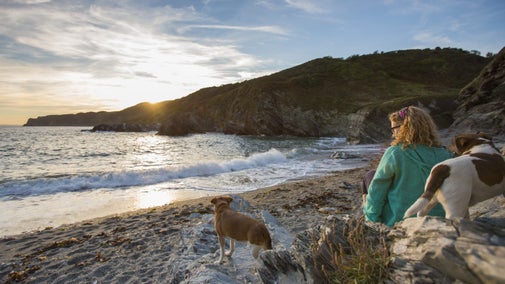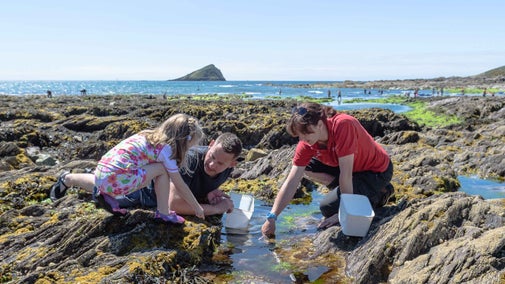
Discover more at Kynance Cove
Find out how to get to Kynance Cove, where to park, the things to see and do and more.

Discover one of the world’s most spectacular beaches, famous for its serpentine stacks, islands, caves and turquoise sea. Explore Kynance Cove, head out for a coastal walk and spot seasonal wildlife.
Kynance Cove is rightly revered as a Cornish gem. Its white sands, turquoise water and serpentine rocks combine to make it one of the most photographed, filmed and painted beaches in Cornwall.
The cove regularly features on lists of the most beautiful beaches in the world, and on a sunny day at low tide you’ll see why it deserves this accolade.
Its name derives from the Cornish ‘kewnans’ meaning ravine, and there is a stream cuts through the valley and across the beach.
Low tide reveals a series of coves and interconnected caves, with splendid Victorian names such as the Ladies Bathing Pool and the Drawing Room.
One rock is named after Prince Albert, who came ashore here with his children in 1846. The largest island is Asparagus Island, named after the plant which is native and grows wild there.
At low tide the caves and stacks are yours to explore, but please be aware of the risks of being cut off by the tide. Kynance Cove has no lifeguards operating and can get extremely busy.

Pull on your walking boots and stride out on a coastal adventure. The South West Coast Path links Kynance Cove with Lizard Point to the south, and Mullion to the north, and this stretch offers walkers fantastic wild scenery.
A popular route is to follow the coast path south between Kynance and Lizard Point, (approximately 2.5 miles), and then return inland via Lizard village and Lizard Downs.
Soapy Cove, one mile along the coast path to the north across Lizard National Nature Reserve, is a wild and isolated spot that is well worth a visit.
A bridleway crosses Lizard Downs inland of Kynance Cove, reaching the A3083 at Mile End, and it is possible to link in with numerous other routes on towards Mullion.
Please go properly equipped and take care if setting out on foot to explore the spectacular scenery around Kynance, as the coastal terrain is wild and isolated, and the weather can change rapidly.
The heaths and cliffs at Kynance Cove support a wide variety of wildlife and plants including asparagus, Cornish heath, ferns, lichens and rare moths.
Listen out for the distinctive ‘chiaow’ call of the chough, a rare species of crow which has returned naturally to Cornwall’s cliffs in recent decades. They can often be seen probing for grubs on the short cliff top turf.

The walk from the National Trust car park, where members can park for free all year, is quite steep with steps at the bottom of the path onto the beach and can take about 10 minutes.
There’s also an alternative pushchair route that's flatter and follows a track around the back of the beach to emerge by the café. This route, which you'll need to take at high tide, takes between 15 to 20 minutes. There is no public vehicular access to the cove.
There's a Trust car park that's open all year at Kynance. The car park is extremely busy and is often full in the summer months and throughout September.
If the car park is full, please visit another time. Alternatively, there's non-Trust private parking available within one mile of the cove (30-40 minute walk).
Be sure to plan your visit by the tide, as the beach almost completely disappears at high tide. Take care not to get cut off by the rising water.

Find out how to get to Kynance Cove, where to park, the things to see and do and more.
Discover the 890 miles of beautiful coastline in our care. Plan your next coastal adventure, whether you want to explore soft, sandy beaches or rugged, windswept cliffs.

Try out the ‘50 things to do before you’re 11¾’ activities children can enjoy by the sea, from paddling or swimming, to catching crabs and skimming stones.

While canoeing and kayaking are great ways to experience nature and keep fit, they can be dangerous if you don't follow the guidelines. Learn how to stay safe with our advice and guidance.

Do you know your ammonites from your devil’s toenails? Discover how to identify some of the fossils commonly found around the UK coast and where you might see them.

Find the best places across England, Wales and Northern Ireland to spot seals in the wild. Whether you're on a coastal walk or boat trip, there are plenty of places to see both grey and common seals as they come ashore to give birth.

Rock-pooling is a great way to get closer to nature. Discover the best places with rock pools to find sea animals like starfish, crabs and anemones at the beaches and coasts we care for.

Fossils can be found anywhere, but you can often find them on beaches where they've been washed out of nearby cliffs. Discover some of the best coastal spots we look after where you might find a fossil or two.

There are miles of natural beautiful coastline and beaches in Cornwall to explore with all the family. There's plenty of space to blow away the cobwebs along the coast.
